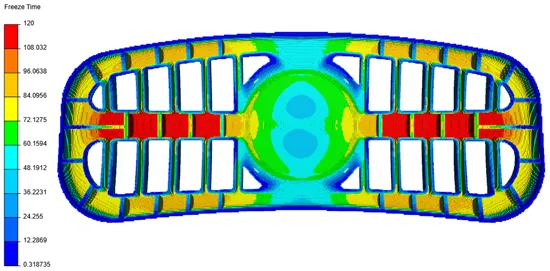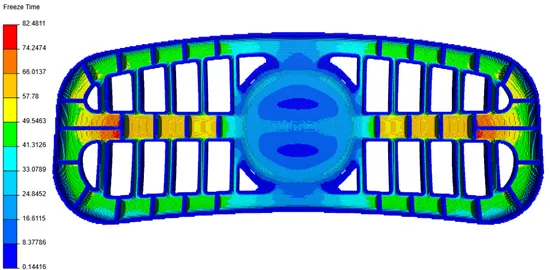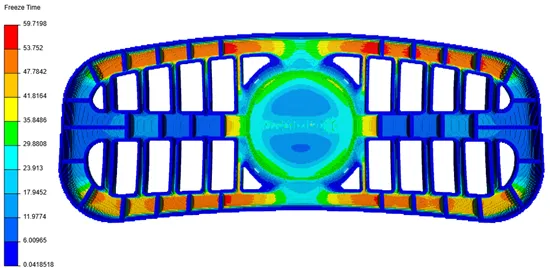by Sarra Zoghlami
In this article, we provide a technical introduction to SimForm: a new way of designing molds with easy mold cooling prediction.
In a plastic injection mold machine, a well-designed cooling system is the key to producing high quality plastic parts, reducing the molding cycle time, and decreasing the production cost. Effective mold cooling reduces the plastic part’s dimensional instabilities, deformation, internal stress, and poor surface quality.
Simform is a web-based application that allows designers to understand the thermal behavior of their plastic injection molds earlier in the design process. SimForm allows you to iterate quickly using a straightforward and easy-to-use workflow.
You can use Simform to run thermal simulations of various cooling designs:
- Without the cooling channels to identify high-temperature areas, and critical components that need to be efficiently cooled. This allows you to make well-calculated decisions about the location of cooling channels and mechanisms like sliders in the mold.
- Using conventional cooling channels, including baffles to reach areas of the plastic part which cannot be cooled effectively with normal cooling channels.
- Using conformal channels that follow the plastic part’s complex shape, to determine whether the added expense yields a more efficient mold.
| Thermal analysis without the cooling channels | Thermal analysis with conventional cooling channels | Thermal analysis with conformal cooling channels |
|---|---|---|
 |  |  |
The material you choose has a significant impact on the heat removal from the plastic part. Use SimForm to test different materials for the mold core, cavity, and inserts to make the best choices for your design.
Setting Up the Mold
Materials
When you set up your mold model, you identify the mold and plastic components and assign materials. SimForm uses the thermal properties of the materials to compute the heat flow from the plastic part, through the mold components to the cooling channels. It accounts for the thermal capacity and the thermal conductivity of the selected materials to compute the temperature distribution in the mold and the plastic part.
Initial Temperatures
When you select the plastic part material, SimForm automatically sets the injection temperature for the plastic part, but you can modify it if necessary. Then, SimForm initializes the temperature distribution on the different components of the mold.
Simform executes multiple injection cycles to reproduce the start-up period and to obtain a realistic temperature distribution in the mold. This distribution becomes the starting mold temperature for a final injection cycle, which produces the results that you can examine. This technique provides reliable results in a short simulation time.
Cooling Temperature
When you identify the cooling channels, you must also specify the temperature of the water as it enters the mold. Then, SimForm determines the temperature increase across the cooling channels.
Running the Simulation
Meshing
SimForm uses an automatic meshing process, which does not require user interaction. This allows Simform to perform the meshing and the calculation on a Graphical Processing Unit (GPU), hosted in the cloud. The mold components are automatically and reliably discretized using a voxel-based mesh. SimForm automatically refines the mesh in regions of high details to correctly capture all the physical phenomena that arise during the injection and solidification process. This automatic meshing process is one of the reasons why SimForm is very efficient.
Temperature Calculation
SimForm is based on a state-of-the-art thermal solver that uses reliable and well-established physics models to perform a full transient thermal simulation of the mold components. It computes the temperature distribution in the plastic parts, mold, and cooling channels and its evolution over time until solidification occurs in the plastic part. The transient temperature distribution helps you to take better decisions about the mold materials and the cooling channel placement, which reduces the molding cycle time and decreases the production cost.
Frozen Layer
During the mold filling, the plastic encounters the mold and quickly solidifies, forming a frozen layer. SimForm calculates the thickness of the frozen layer as the depth of the plastic material touching the mold at a temperature below the solidification temperature of the plastic.
Examining the Results
Plastic Part Temperature
On the SimForm results page, you can:
- Examine the plastic part temperature distribution and its evolution over time.
- Display the temperature distribution on the surface of the plastic part or inside its volume.
- Use cutting planes and isosurfaces to better analyze the temperature distribution.
Locate the areas that need more cooling.
Safe Ejection Time
The safe ejection time, also called the freeze time, is the time required for the plastic part to develop a frozen layer thick enough for the part to be ejected and retain its structural integrity. SimForm calculates the safe ejection time as the time required for the frozen layer in all locations to be at least 20% of the local plastic part thickness. At the end of the simulation, SimForm reports the overall freeze time. On the SimForm results page, you can display the local freeze time results, which show how long it takes for each point on the plastic part surface to freeze enough to be safe for ejection. This reveals which areas of the part are driving the cooling cycle time.
Mold Temperature
The temperature distribution in the mold helps you identify high-temperature areas. You can use the results to make better decisions about the design of the mold, the need for inserts, and the location of cooling channels. It can also provide insights into areas where there is unnecessary cooling, thus saving on tooling costs.
Takeaways
In this article, we introduced SimForm and how it works. In subsequent articles, we will dive in to learn specific features of the software to address your use cases. SimForm will change your way of designing plastic injection molds — giving you valuable insights that you can act on earlier in the design process.